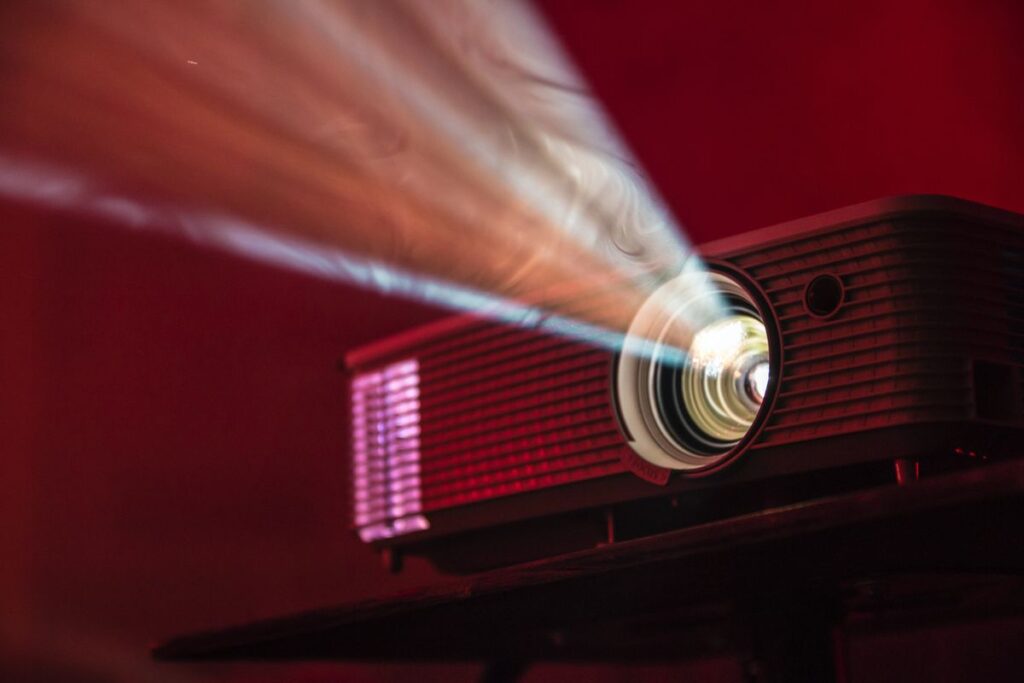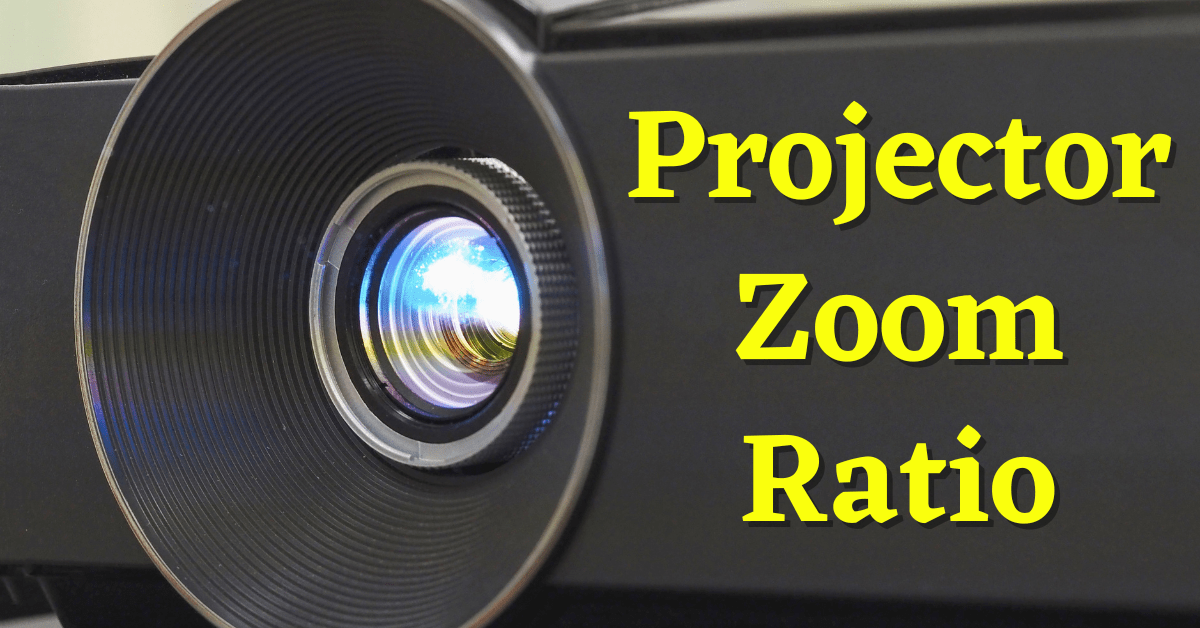Last Updated on September 20, 2024 by Admin
When it comes to choosing a projector, understanding technical terms like “zoom ratio” and “throw ratio” is crucial for making the right choice. These two specifications directly affect the placement of your projector, the size of the image on your screen, and how flexible your setup can be.
In this article, we will dive deep into what a projector zoom ratio is, how it differs from throw ratio, and why both are important factors to consider before buying a projector.
You might also be interesting in understanding the Types of Projector.
Page Contents
What is Projector Zoom Ratio?
The projector zoom ratio refers to the ability of a projector to enlarge or shrink the size of the projected image without physically moving the projector.
It is a key factor that determines how much flexibility you have when positioning your projector in relation to the screen. For instance, if a projector has a zoom ratio of 1.2:1, it means you can increase the image size by 20% without changing the projector’s location.
A zoom ratio is often represented in the form of two numbers, such as 1.2:1 or 2.0:1. These numbers show the relationship between the largest and smallest image sizes that can be produced at a fixed distance from the screen. For example, a 2.0:1 zoom ratio indicates that the image size can be doubled without needing to reposition the projector.
Let’s take this Epson Home Cinema 5050UB 4K Projector as an example. It has a Zoom Ratio of 1.0 to 2.1. That means you can Zoom In from 1.0 to 2.1

How Does Projector Zoom Ratio Work?
The projector zoom ratio works through the use of a zoom lens, allowing users to adjust the projected image size by changing the focal length of the lens. This means you can have a smaller or larger image on the screen without moving the projector closer or farther from the screen.
In practical terms, a higher zoom ratio provides more flexibility in projector placement. This can be particularly useful in rooms where space is limited, or in setups where you want to adjust the screen size based on the audience or environment.
Some projectors offer both optical and digital zoom features, but optical zoom is preferred because it maintains image quality, while digital zoom can degrade the image by scaling it electronically.
What is a Throw Ratio?
While the projector zoom ratio is all about image size flexibility, the throw ratio defines the relationship between the distance of the projector from the screen and the width of the projected image.
Throw ratio is a fixed value, and it’s usually expressed as a single number like 1.5:1 or 0.8:1. A throw ratio of 1.5:1 means that for every 1.5 feet of distance between the projector and the screen, the image width will be 1 foot.
We have already explained How Projector Throw works in this detailed article.
Projectors can be classified into different categories based on their throw ratio: Short throw, Long throw, and Ultra-Short throw.
We have a detailed article explaining the difference between Short Throw Vs Ultra-Short Throw Vs Long Throw Projector

Difference Between Throw Ratio Vs Zoom Ratio:
Now that we understand both terms, let’s compare throw ratio vs zoom ratio. While both relate to how an image is projected onto a screen, they serve different purposes:
Throw Ratio is about the distance between the projector and the screen relative to the image width. It is a fixed value and determines where you need to place the projector to get the desired image size.
Zoom Ratio gives you the ability to adjust the size of the image without moving the projector, offering flexibility in terms of screen size while keeping the projector in one spot.
| Aspect | Throw Ratio | Zoom Ratio |
|---|---|---|
| Definition | Distance between projector and screen vs. image size | Ability to adjust image size without moving it |
| Fixed/Adjustable | Fixed ratio | Adjustable ratio |
| Placement Impact | Affects placement distance | Allows flexibility in screen size |
How to Calculate Projector Zoom and Throw Ratio
Calculating projector zoom and throw ratios is relatively straightforward. For the throw ratio, divide the distance from the projector to the screen by the width of the projected image. For example, if the projector is placed 10 feet away from the screen and the image width is 5 feet, the throw ratio would be 10 ÷ 5 = 2.0:1.
To calculate the zoom ratio, simply check the projector’s specifications. For instance, if the zoom ratio is listed as 1.5:1 to 2.0:1, it means the projector can adjust the image size between 1.5 times and 2 times the smallest size without moving the projector.
How to Find Projector Zoom Lens Ratio?
You will find the Projector Zoom Lens Ratio in the Projector Specifications.
Impact of Zoom and Throw Ratios on Image Quality
While zoom and throw ratios significantly affect how you can position and use your projector, they also have implications for image quality.
In general, using the zoom function (particularly optical zoom) should not degrade the image quality. However, overusing digital zoom can lead to a loss of clarity and sharpness because it involves scaling the image digitally.
The throw ratio impacts image quality as well, especially in short throw and ultra-short throw projectors. These projectors are designed to project larger images from shorter distances, but the closer proximity can sometimes result in image distortion or focus issues if the lens quality isn’t high enough.
Also, Check out What is Keystone Correction in Projectors.

Frequently Asked Questions
What is a good zoom ratio for home projectors?
A good zoom ratio for home projectors is typically between 1.2:1 and 2.0:1, offering enough flexibility to adjust the image size based on your room setup.
Can you change the throw ratio on a projector?
No, the throw ratio is fixed and determined by the design of the projector’s lens. However, some projectors come with multiple lens options to change the throw ratio.
Does zoom ratio affect picture quality?
Optical zoom does not affect picture quality, but digital zoom can degrade image quality by scaling the image electronically.
How do I know if a projector has a good throw ratio?
A good throw ratio depends on your room size and needs. For small rooms, look for a short throw ratio (below 1:1). For larger spaces, a long throw projector with a ratio above 1.5:1 may be more suitable.
Conclusion:
Understanding both projector zoom ratio and throw ratio is essential for optimizing your projector setup. The zoom ratio provides flexibility in adjusting screen size, while the throw ratio determines where the projector should be placed. Together, these two factors will guide you in selecting the perfect projector for your needs, ensuring that your image is the right size and quality for your space.
Before making a purchase, consider the room’s dimensions, the type of content you’ll be viewing, and whether the projector offers the zoom and throw flexibility needed for your environment. With the right combination of throw ratio and zoom ratio, you’ll get the best projection experience possible.

